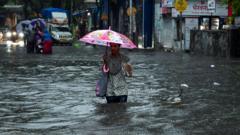Walking challenges in Indian cities stem from poorly maintained footpaths, vehicle encroachment, and a lack of policy focus on pedestrian safety. Activists are calling for urgent improvements to make urban environments more walkable.
Struggling to Walk: The Pedestrian Crisis in Indian Cities

Struggling to Walk: The Pedestrian Crisis in Indian Cities
The dire state of footpaths in India is a growing concern for citizens as more advocate for pedestrian-friendly infrastructure.
In India, pedestrians face numerous challenges while navigating city footpaths, which are often littered with obstacles and in disrepair. Arun Pai, a resident of Bengaluru, discovered this firsthand through community engagement initiatives aimed at understanding pedestrian experiences. This month, he launched the 'world's longest footpath run,' inviting participants to map obstacles along an 11-kilometer stretch of the city's footpaths, collecting crucial data to pressure local authorities for change.
Pai, founder of the non-profit Bangalore Walks, represents a growing movement among citizen activists. In a similar vein, Delhi by Cycle advocates for a more bicycle-friendly and walkable urban landscape in the capital. Participants in awareness campaigns, app development, and political lobbying seek to transform the often chaotic and unsafe environment for pedestrians in India's bustling urban centers.
The situation is stark across India’s major cities, where footpaths are frequently obstructed by street vendors, illegally parked vehicles, and sometimes serve as temporary homes for the homeless. Many existing footpaths are not built to adequate standards and lack maintenance, making walking a perilous undertaking through heavily congested roadways.
In Mumbai, a group called Walking Project released a 'pedestrian manifesto' preceding state elections, detailing demands for better walking conditions, dedicated space for hawkers, and improved accessibility for those with mobility challenges. According to Vendant Mhatre, the group's convener, 50% of Mumbai's residents rely on walking for transportation, yet this demographic receives scant attention in transport policy planning.
The consequences are alarming; government statistics indicate that pedestrian fatalities rank second only to two-wheeler accidents, with over 10,000 pedestrian deaths reported on national highways in 2022. Mhatre criticized the common approach of merely implementing temporary fixes, urging for the construction of interconnected footpaths that accommodate high pedestrian volumes.
Research from Chennai showcased how enhancing footpaths can lead to significant environmental benefits: a 9% to 27% increase in pedestrians opting for walking over motorized transport, which translated into reduced greenhouse emissions. Additionally, improved infrastructure creates economic opportunities for underprivileged groups, reducing their transport costs.
The lack of awareness regarding the standards for pedestrian infrastructure often results in complacency among citizens. Many view walking as a leisurely activity rather than a necessity for daily commuting, limiting the perception of the required improvements for walking infrastructure.
Civil engineering professor Geetam Tiwari points out that urban planning often prioritizes car traffic relief at the expense of pedestrian pathways. She advocates for maintaining and prioritizing footpaths, suggesting that addressing pedestrian needs could alleviate traffic congestion in the long run. Furthermore, Tiwari encourages the federal government to mandate adherence to design standards for roads, emphasizing the importance of Non-Motorised Transport Policies across more Indian cities.
As citizens stand up for their right to walk safely, it becomes increasingly evident that transformative changes are necessary to prioritize pedestrian infrastructure and ensure the safety and accessibility of urban environments across India.
Pai, founder of the non-profit Bangalore Walks, represents a growing movement among citizen activists. In a similar vein, Delhi by Cycle advocates for a more bicycle-friendly and walkable urban landscape in the capital. Participants in awareness campaigns, app development, and political lobbying seek to transform the often chaotic and unsafe environment for pedestrians in India's bustling urban centers.
The situation is stark across India’s major cities, where footpaths are frequently obstructed by street vendors, illegally parked vehicles, and sometimes serve as temporary homes for the homeless. Many existing footpaths are not built to adequate standards and lack maintenance, making walking a perilous undertaking through heavily congested roadways.
In Mumbai, a group called Walking Project released a 'pedestrian manifesto' preceding state elections, detailing demands for better walking conditions, dedicated space for hawkers, and improved accessibility for those with mobility challenges. According to Vendant Mhatre, the group's convener, 50% of Mumbai's residents rely on walking for transportation, yet this demographic receives scant attention in transport policy planning.
The consequences are alarming; government statistics indicate that pedestrian fatalities rank second only to two-wheeler accidents, with over 10,000 pedestrian deaths reported on national highways in 2022. Mhatre criticized the common approach of merely implementing temporary fixes, urging for the construction of interconnected footpaths that accommodate high pedestrian volumes.
Research from Chennai showcased how enhancing footpaths can lead to significant environmental benefits: a 9% to 27% increase in pedestrians opting for walking over motorized transport, which translated into reduced greenhouse emissions. Additionally, improved infrastructure creates economic opportunities for underprivileged groups, reducing their transport costs.
The lack of awareness regarding the standards for pedestrian infrastructure often results in complacency among citizens. Many view walking as a leisurely activity rather than a necessity for daily commuting, limiting the perception of the required improvements for walking infrastructure.
Civil engineering professor Geetam Tiwari points out that urban planning often prioritizes car traffic relief at the expense of pedestrian pathways. She advocates for maintaining and prioritizing footpaths, suggesting that addressing pedestrian needs could alleviate traffic congestion in the long run. Furthermore, Tiwari encourages the federal government to mandate adherence to design standards for roads, emphasizing the importance of Non-Motorised Transport Policies across more Indian cities.
As citizens stand up for their right to walk safely, it becomes increasingly evident that transformative changes are necessary to prioritize pedestrian infrastructure and ensure the safety and accessibility of urban environments across India.





















